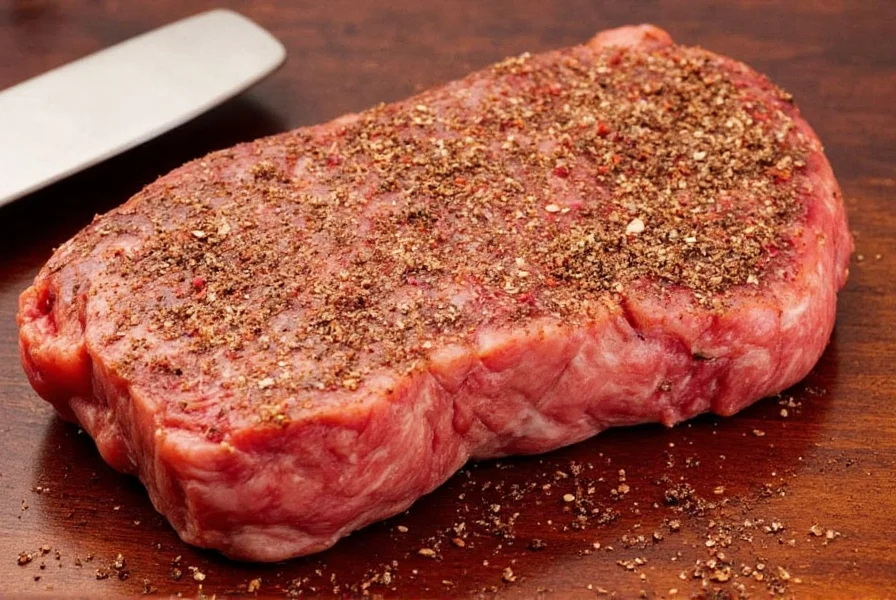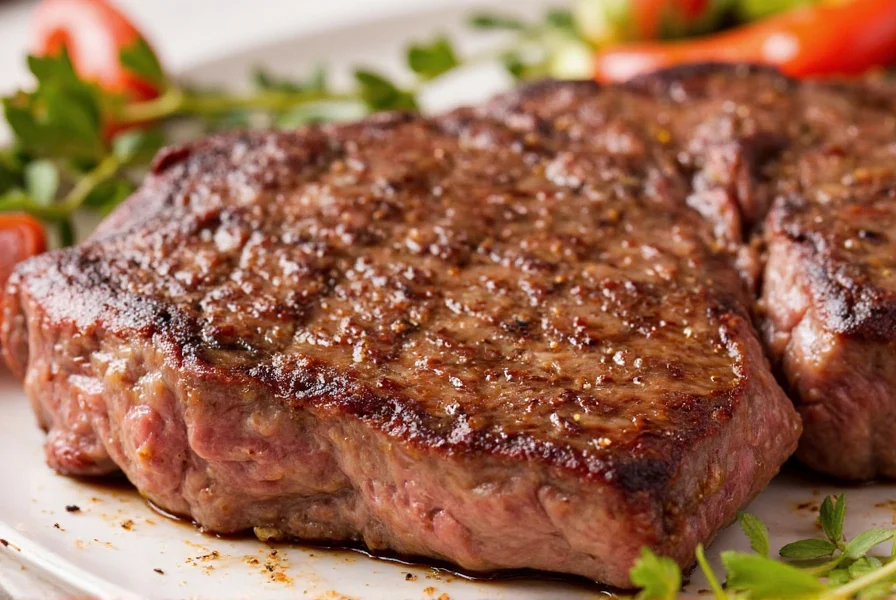Mastering Steak Seasoning: Science and Technique
Proper seasoning transforms an ordinary steak into an extraordinary meal. While seemingly simple, the timing, quantity, and selection of seasonings significantly impact flavor development, crust formation, and overall eating experience. Understanding the chemistry behind salt penetration and moisture management separates amateur attempts from restaurant-quality results.
The Science Behind Steak Seasoning
Salt doesn't just add flavor—it alters the meat's protein structure. When applied early, salt dissolves, forms a brine with the meat's natural juices, and is reabsorbed, seasoning from within while improving moisture retention. This process, called dry brining, creates more evenly seasoned meat compared to last-minute salting.
Essential Seasoning Components
While personal preferences vary, three elements form the foundation of effective steak seasoning:
Salt Selection and Application
Coarse kosher salt (like Diamond Crystal) is preferred by most chefs for steak seasoning. Its larger crystals distribute more evenly and provide better control than fine table salt. The ideal amount is approximately 1 teaspoon of kosher salt per pound of meat. For thinner cuts (under 1 inch), apply salt 40-60 minutes before cooking. For thicker cuts (1.5 inches or more), dry brine by salting 12-24 hours in advance and refrigerating uncovered to dry the surface.
Pepper Timing Matters
Contrary to popular belief, adding pepper before cooking can cause it to burn at high temperatures, creating bitter compounds. For best results, apply freshly ground black pepper just before placing the steak on the cooking surface. If you prefer pepper throughout, consider adding half before cooking and the remainder after.
| Steak Thickness | Salt Application Time | Salt Quantity (per pound) | Pepper Application |
|---|---|---|---|
| Under 1 inch | 40-60 minutes before | 3/4 teaspoon | Just before cooking |
| 1-1.5 inches | 1-2 hours before | 1 teaspoon | Half before, half after |
| Over 1.5 inches | 12-24 hours before | 1.25 teaspoons | After cooking |
Step-by-Step Seasoning Process
Preparation
Remove steak from refrigerator 60-90 minutes before cooking to bring it to room temperature. Pat thoroughly dry with paper towels—this critical step ensures proper browning. For dry brining, complete this step 12-24 hours in advance and refrigerate uncovered.
Dry Brining (Optional but Recommended)
For premium results, especially with thicker cuts, dry brining significantly improves flavor penetration and texture. Apply salt evenly on all surfaces, then place on a wire rack over a plate in the refrigerator for 12-24 hours. This extended time allows salt to penetrate deeper while the uncovered refrigeration dries the surface for superior searing.

Final Seasoning Before Cooking
Just before cooking, apply additional seasonings. Beyond salt and pepper, consider:
- Garlic powder (not fresh garlic, which burns)
- Onion powder
- Paprika for color and mild sweetness
- Herbs like thyme or rosemary (use sparingly)
Remember that simpler is often better—overcomplicating steak seasoning can mask the meat's natural flavor.
Common Steak Seasoning Mistakes
Avoid these frequent errors that compromise your perfectly cooked steak:
Mistake #1: Salting Too Close to Cooking Time
Applying salt immediately before cooking draws moisture to the surface without allowing time for reabsorption, creating a steamed rather than seared exterior. The minimum effective window is 40 minutes for thinner cuts.
Mistake #2: Using Table Salt Instead of Kosher Salt
Table salt's fine crystals contain about twice the sodium by volume compared to kosher salt. Using equal amounts results in oversalted steak. If substituting, use half the recommended kosher salt quantity.
Mistake #3: Adding Liquid Marinades Before High-Heat Cooking
Wet marinades create steam when hitting a hot surface, preventing proper Maillard reaction. If using marinades, pat the steak completely dry before cooking or reserve marinade for basting after the crust has formed.
Advanced Seasoning Techniques
Once you've mastered basic seasoning, consider these professional approaches:
Finishing Salts
After cooking, sprinkle a small amount of flaky sea salt (like Maldon) for a delicate crunch and burst of salinity that enhances the finished steak without overwhelming it.
Compound Butter Finish
Create a simple compound butter by mixing softened butter with minced herbs, garlic, and a pinch of salt. Place a small pat on the hot steak during the resting period—the residual heat melts the butter, creating an instant sauce that complements rather than masks the meat's flavor.
Special Considerations for Different Cuts
Not all steaks season the same way. Understanding cut-specific needs improves results:
- Filet mignon: Mild flavor benefits from more aggressive seasoning
- Ribeye: Rich marbling means less seasoning needed to enhance natural flavors
- Flank/skirt steak: Benefit from acidic components (like citrus zest) in seasoning
- Wagyu/Kobe: Minimal seasoning recommended to appreciate delicate marbling
Seasoning for Different Cooking Methods
The cooking technique affects optimal seasoning approach:
- Grilling: Use slightly more seasoning to compensate for flavor loss to flames
- Cast iron: Ensure thorough drying before seasoning for best crust formation
- Sous vide: Season before vacuum sealing, but add finishing salt after searing
- Reverse sear: Salt during the low-temperature phase for maximum penetration
FAQ: Steak Seasoning Questions Answered
When is the absolute latest I can salt my steak before cooking?
The minimum effective window is 40 minutes before cooking for thinner cuts. This allows enough time for the salt to dissolve, draw out moisture, and be reabsorbed into the meat. Salting less than 30 minutes before cooking creates excess surface moisture that prevents proper browning.
Can I use sea salt instead of kosher salt for seasoning steak?
Yes, but adjust quantities carefully. Fine sea salt has similar density to table salt, so use about half the amount of kosher salt. For flaky sea salts like Maldon, use them as a finishing salt after cooking rather than for initial seasoning due to their delicate texture and intense flavor bursts.
Why does my pepper burn when I season steak before grilling?
Black pepper contains compounds that burn at temperatures above 400°F (204°C), creating bitter flavors. Most grilling and searing occurs at 450-500°F (232-260°C). To prevent this, add pepper just before cooking or after the crust has formed. Alternatively, use half before cooking and finish with additional pepper after cooking.
How do I season steak without salt for dietary restrictions?
For salt-free seasoning, focus on maximizing flavor through other means: use generous amounts of freshly ground black pepper, garlic powder, onion powder, smoked paprika, and dried herbs. Consider finishing with a squeeze of citrus or a flavored oil. Remember that proper cooking temperature and resting time become even more critical for flavor development when omitting salt.
Does the dry brining method work for all steak thicknesses?
Dry brining works best for steaks 1.25 inches or thicker. For thinner cuts (under 1 inch), extended dry brining can over-salt the meat. Instead, use the 40-60 minute salting window for thinner steaks. The goal is to allow enough time for salt penetration without creating an overly salty exterior before the center receives adequate seasoning.











 浙公网安备
33010002000092号
浙公网安备
33010002000092号 浙B2-20120091-4
浙B2-20120091-4